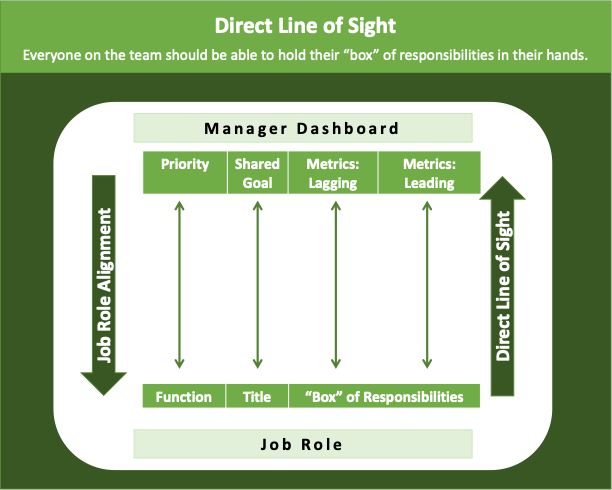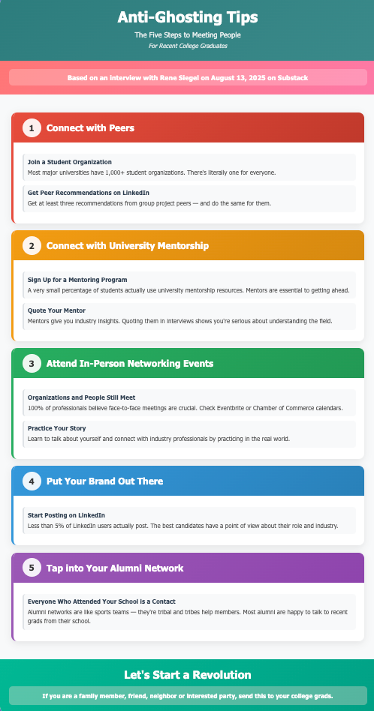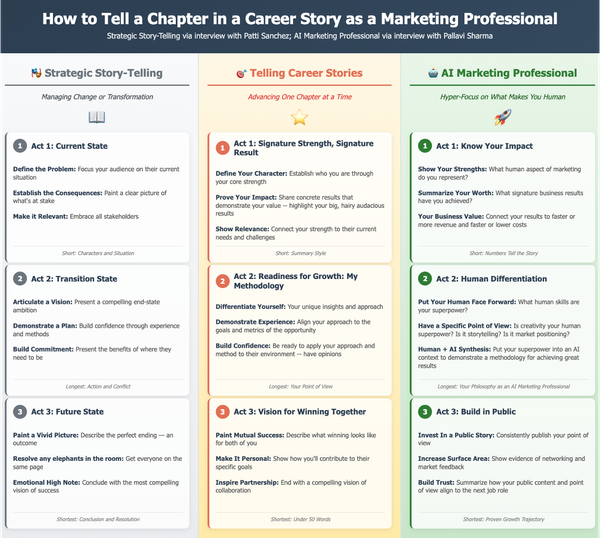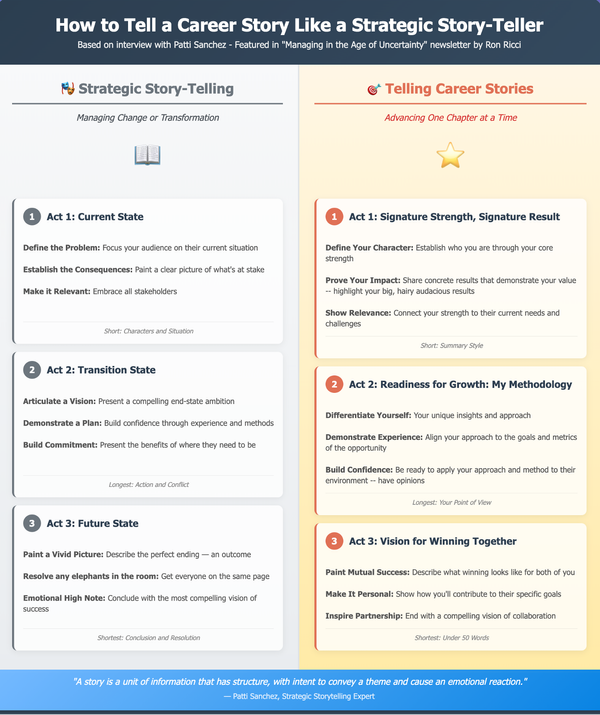Is the Stretch Assignment Dead?

The boomer generation of managers had a handful of “catch phrases” that existed only because the corporate ladder existed. Any boomer manager likely used all three of these expressions at some point during career conversations with people on their teams:
- “Managing your career is your responsibility.”
- “You need to do the next job before you get the next job.”
- “You need a stretch assignment to show you’re ready.”
In a world where the next role was a clearly marked on the corporate ladder, these management concepts actually helped move a career forward. Remember, the corporate ladder was well-established. In Cisco, you went from grade 8, to grade 9, to 10, to 11 to 12 and ultimately to the greatly coveted grade 13, “director” level.
It was so easy for boomers to chart their career path up these grade levels. That’s why boomer managers could say things like “you need to do the next job…” and boomer ICs knew exactly what those words meant.
If you’re a millennial or gen-z, it’s unlikely you will ever have this common boomer experience: A ten-year path — a decade! — in a single function — yes, a single function! — in one company — one place! — maybe even with the same manager — that’s right, the same manager for an entire decade! — to move from grade 8 to grade 13. A decade-long career path. Neat and clean.
The “Five Dots of a Career Story”
In this issue of Managing in the Age of Uncertainty, I’m continuing my series on the “Five Dots of a Career Story.” The next generation know they won’t have an employment experience like their parents — that’s why it’s called the age of uncertainty. It’s also why the best millennials and gen-z are always looking to write the next chapter of their career story; they know they need to chart their own course.
The next generation of talent seek out managers who “get this,” according to my research. Millennials and gen-z want to work for managers who can help them build a chapter of a career story, one built around their current job role. “Career as a story” is a new idea, especially for boomer managers; it’s why I developed the “Five Dots” framework specifically to help managers and individual contributors (ICs) “connect the dots” to align a job role to a career story.
As a manager, you want to motivate your people. At the same time, a motivated team helps you achieve your goals.
Last week I shared how to make a job role “tangible” — dot number 1. This week, I’m focusing on how a manager can help shape future growth for someone — dot number 2. And yes, I’ll be recommending end of the “stretch assignment.” It’s time to re-think this boomer concept.
Reminder: The 5 Dots Framework

Shaping Future Growth
Individual contributors on a team want to know how a current role shapes their future opportunities. I contacted my former colleague Jason Angelus to ask him about shaping future growth for ICs, and how he did it on his team at Cisco. “First and foremost, a manager needs to tell the team you are supportive of anyone wanting to grow themselves,” Jason said.
It’s a great point. Managers: when was the last time you told your team to come to you with proposals on how they can grow themselves? It’s a great way to start the career as a story process with your people.
After talking to Jason, I came came away believing a manager can shape the future growth of an IC by doing three things well:
- Start with strengths: It’s possible to predict future success by helping people on the team understand their innate abilities. Any manager should want a team playing to its strengths — to bring out the best in people. But — sometimes — people want to believe they are good at things they aren’t. I’ve always said that the more people fall in love with themselves, the more likely they are to excel at what they’re doing. Shaping someone’s future will only work if it is based on what someone brings to the table — it’s your job as a manager to get people to fall in love with themselves!
- Align Strengths and Skills: It’s important that every job description include both the responsibilities of the role, but also the skills required to be successful in the role. Most job descriptions focus on required experience — a total boomer concept. What’s far more important are the skills required to excel in a role. Your job as a manager is to align someone’s strengths with the skills needed. In growth conversations with your people, ask them to describe their strengths and how they align to a job role and the skills necessary to be great at the role. When people know they are playing to their strengths, it only increases their self-confidence and the effort the put in to exceed expectations — which only helps you as a manager exceed your expectations.
- Give People Space; Don’t Give them Stretch Assignments. Jason is really passionate about giving people space to grow within their current job role. He said it better than I could write:
“Stretch assignments are often billed as a way for someone to try something new or interact with a new team. Unfortunately, they often have poorly defined structure, outcomes and timelines. They can be very de-motivating for an IC or an early in career manager and leave everyone disappointed. The way to avoid this failure is to make them real, make them part of the person’s day job, not a ‘let’s add more to your plate, but keep doing your day job’ assignment.”
In all my years managing, I never had a single meeting with an individual contributor about their careers that didn’t excite them. One of the “Five Dots” is a conversation about shaping future growth. It’s a chance to build self-confidence for your people in who they are, what they bring to the team. The more you align strengths, skills and space, the more excited everyone will be about their future.
Manager Thought of the Week
“Never create a position out of weakness.“
Okay, I’m quoting myself. My worst mistakes as a manager were when I tried to “save someone” by creating a role for them when they weren’t succeeding in their current role. Maybe I thought I saw something in the person that wasn’t there or maybe I didn’t like giving bad news or maybe I am just an optimist — regardless, every single time I created a position out of weakness it lead to hurt feelings and failed expectations. Former GE CEO Jack Welch told me: “Tell people the truth.” I couldn’t agree more.
In Summary: Principles of Managing in the Age of Uncertainty
- I left Cisco to answer this question with research and evidence: What does the manager of the future look like? What are millennials and gen-z seeking in a manager? Which behaviors, tactics, skills or processes matter? What’s it going to take to attract and keep the best people over the next decade? In short, how to be a great manager.
- Based on this research, the core philosophy of this newsletter is rooted in one idea: successful managers in this moment in time, for this generation of talent, need to be “career dot-connectors.” The next-gen doesn’t expect to spend their entire career on your team — that’s an idea boomers grew up with. A job on your team is like a chapter in a career story to the current generation. If you want the best people on your team, you have to connect the dots between roles on the team and the career opportunities of the people working on the team.
- What is the“Age of Uncertainty”? If the industrial age was about taking predictable steps up the ladder, the age of uncertainty is about finding or discovering the path of a career without any predictable steps, without an obvious ladder — it’s why being a career dot-connector will differentiate you as a manager.
- How to be a Great Manager in the Age of Uncertainty: Be a Career Dot Connector is available on Amazon.
- What kind of manager are you? Take my free self-assessment and learn about yourself.




